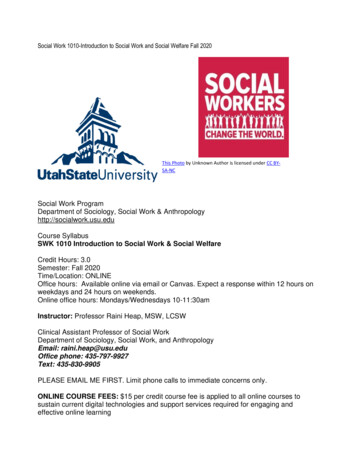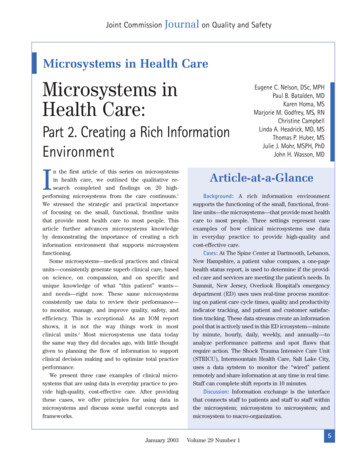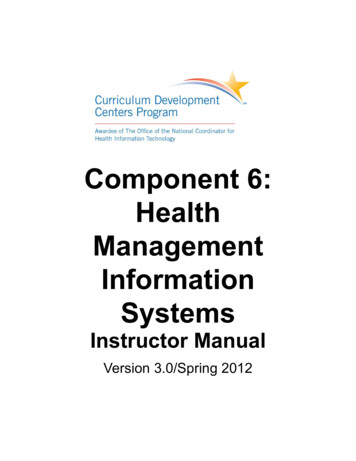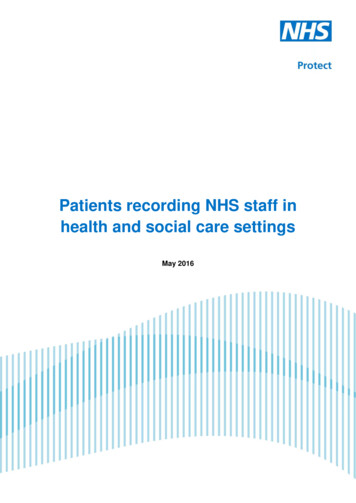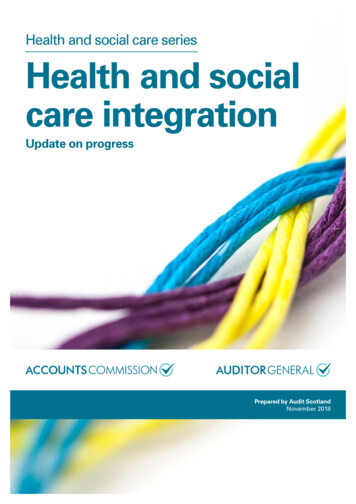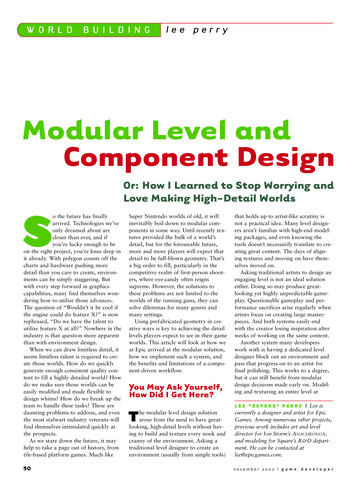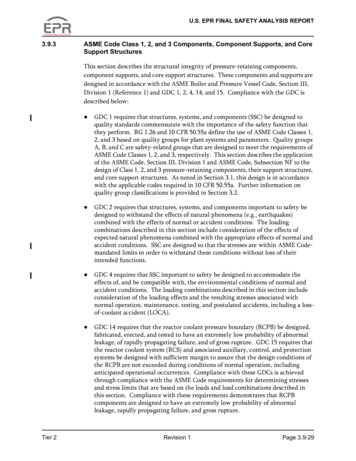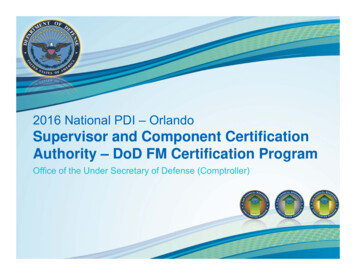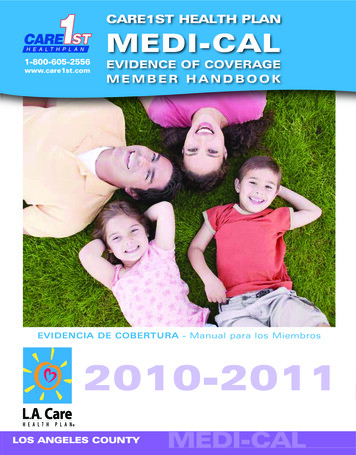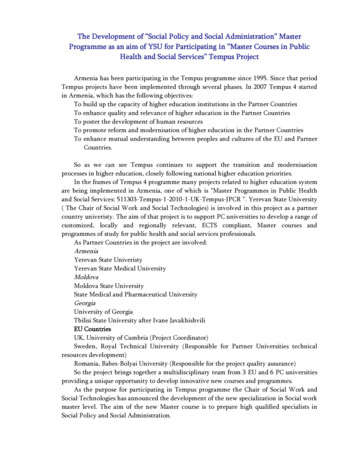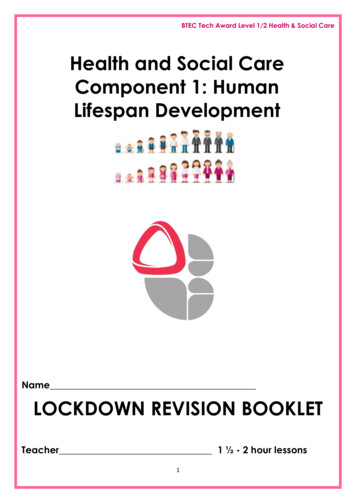
Transcription
BTEC Tech Award Level 1/2 Health & Social CareHealth and Social CareComponent 1: HumanLifespan DevelopmentNameLOCKDOWN REVISION BOOKLETTeacher 1 ½ - 2 hour lessons1
BTEC Tech Award Level 1/2 Health & Social CareThis is a lockdown booklet, to complete at home, as a revisionexercise. Component 1, is assessed by two pieces of course work,however, some of the learning is used in the Component 3 exam, inYear 11, so this is a good activity workbook.Task – jot down what you remember of Component 1, below2
BTEC Tech Award Level 1/2 Health & Social CareComponent 1Learning content to be coveredA1 Human growth and development across life stagesLearners will explore different aspects of growth and development across the life stagesusing the physical, intellectual, emotional and social (PIES) classification.A2 Factors affecting growth and developmentLearners will explore the different factors that can affect an individual’s growth anddevelopment. Different factors will impact on different aspects of growth anddevelopment.B1 Different types of life eventLife events are expected or unexpected events that occur in an individual’s life. Learnerswill explore the different events that can impact on people’s physical, intellectual,emotional and social development.B2 Coping with change caused by life eventsLearners will explore how individuals can adapt, or be supported through changescaused by life events. People may react very differently to the same type of event.Learning Aim A: Understand human growth and development across life stages andthe factors that affect itA1 Main life stages:Infants (birth to 2 years)Early childhood (3–8 years)Adolescence (9–18 years)Early adulthood (19–45 years)Middle adulthood (46–65 years)Later adulthood (65 years).A1 PIES growth and development in the main life stagesPhysical growth and development across the life stages, includingGross and fine motor skills,Growth patterns,Primary and secondary sexual characteristics,Menopause,Loss of mobility,Muscle tone/strength and skin elasticity3
BTEC Tech Award Level 1/2 Health & Social CareIntellectual/cognitive development across the life stages, includingLanguage development,Problem solving,Abstract and creative thinking,Development/loss of memory and recallEmotional development across the life stages, includingBonding and attachment,Independence and self-esteem,Security,Contentment,Self-imageSocial development across the life stages, includingThe formation of relationships with others and the socialisation process.A2 Factors affecting growth and developmentGenetic inheritancePhysicalfactors, toinclude:Experience of illness and diseaseDiet and lifestyle choicesAppearance.Culture, e.g. community involvement, religion, gender roles andexpectationsSocial andculturalfactors, toinclude:Educational experiencesThe influence of role modelsThe influence of social isolationPersonal relationships with friends and family.Economicfactors, toinclude:Income/wealthMaterial possessions.4
BTEC Tech Award Level 1/2 Health & Social CareLearning aim B: Investigate how individuals deal with life eventsB1 Different types of life eventPhysicalevents, toinclude:Accident/injuryRelationshipchanges, toinclude:Entering into relationshipsIll ving house, school or jobcircumstances,Exclusion from educationto include:RedundancyImprisonmentRetirementB2 Coping with change caused by life eventsHow individuals adapt to these changes.Sources ofsupport:Family, friends, partnersProfessional carers and servicesCommunity groups, voluntary and faith-based organisations.Types ofsupport:EmotionalInformation and advicePractical help, e.g. financial assistance, childcare, transport.5
BTEC Tech Award Level 1/2 Health & Social CareKey TermsPrepared using the BTEC First Edexcel Health and Social Care book by Pearson, whichyou can access online.Life Stages: A number of distinct phase’s people pass through during their lives.What are PIES Developments?P – Physical Development Gross motor skills and fine motor skillsI – Intellectual Development Language development – egocentric view of the worldE- Emotional Development Bonding with othersS- Social Development Interaction with others.Gross Motor Skill: The ability to move and co-ordinate the movement of the large limbsof the body, e.g. crawling, walking, and climbing, running.Fine Motor Skills: The ability to move and co-ordinate the movement of the hands andfingers, e.g. writing, painting, tying shoe laces, holding a spoon.Language Development: The Process which children go through as they learn tocommunicate with others using words and speech.Egocentric: Seeing things from only your own perspective or viewpoint.Bond: To form an attachment with a parent or carer.Growth: An increase in size, height and weight which can be measured.Development: How the child gains skills and is able to control the actions their bodymakesSelf-Image The mental picture we have of ourselves. Some people see themselves in apositive light – for instance, intelligent, attractive and talented whereas other may seeonly negatives.Self Esteem How much you like, accept and respect yourself – this is often talked aboutin terms of how much you value yourself.Social Development The ability to interact with others and build relationships.Oestrogen: A hormone produced in a woman's ovaries that controls the developmentof sexual characteristics and stimulates changes in the reproductive organs.Testosterone: A hormone produced by the testes that controls the development ofmale sexual characteristics.6Abstract thinking: the ability to think about something that might not be there or even
BTEC Tech Award Level 1/2 Health & Social CarePhysical mentSocial development7
BTEC Tech Award Level 1/2 Health & Social CareLesson 1 – Complete pages 7-9Unit 1: Human Lifespan Development:The Life stages and key developmentAgeLife StageWhat key points for this lifestage?InfancyEarly ChildhoodAdolescenceEarly AdulthoodMiddleAdulthoodLater Adulthood8What life stages are yourfamily? Name them
BTEC Tech Award Level 1/2 Health & Social CareUnit 1: Human Lifespan DevelopmentDraw a Time Line starting at 0 to 70 years-old, using correct terms9
BTEC Tech Award Level 1/2 Health & Social CareLesson 2; Pages 11-14Unit 1: Human Lifespan DevelopmentApply your learning to these case studiesRomeo is 15 years old.He lives at home with his family and goes to the localschool.He enjoys playing football in his spare time.Which life stage is Romeo in?Romeo is in the .lifestageThis photo shows Jake with his grandparents.Complete these sentences to show thecurrent life stage of each person.(a) Angie is in the life stage.(b) Jake is in the . life stage.(c) Geoff is in the . life stage.Sarah has just given birth to Maddie. Here isSarah’s mum Angela meeting hergranddaughter for the first time.(a) Maddie is in the . life stage.(b) Sarah is in the . life stage.(c) Angela is in the . life stage.10
BTEC Tech Award Level 1/2 Health & Social CareLesson 2Unit 1: Human Lifespan DevelopmentPhysical, Intellectual, Emotional and Social Development are also referred toas PIES. Development can be defined as the ability to acquire new skills andcapabilities.This can be done in all areas of PIES.PhysicalIntellectualGross motor skill and fine motor skillsLanguage development – acquisition oflanguage. Cognitive development thinking and making sense of the worldegocentric view of the worldDevelopmentEmotionalSocialBonding with othersInteraction with others11
BTEC Tech Award Level 1/2 Health & Social CareLesson 2 – now write your understanding of the belowUnit 1: Human Lifespan DevelopmentPhysical developmentIntellectual developmentEmotional developmentSocial development12
BTEC Tech Award Level 1/2 Health & Social CareLesson 2Unit 1: Human Lifespan DevelopmentApply your learning to the case studies belowNadeem was bullied in his last year at school. He is due to start College soon, but isworried because he now finds it difficult to socialise with other young people.Identify two aspects of Nadeem’s development that have been most affected bybullying.(a)(b)Baby Brad is 6 months old. His mother, Alexa, has takenhim to the baby clinic for his six-month check-up. Thephoto opposite shows him being weighed.Which aspect of Brad’s development is the nursechecking?(a)What will be measured?(b)(c)Where are the measurements put (on a graph), what is the graph called?13
BTEC Tech Award Level 1/2 Health & Social CareInfancyEarly ChildhoodAdolescenceEarly AdulthoodMiddle AdulthoodLater AdulthoodPhysicalEmotionalSocialLesson 2 – Baby Brad grows, write below, key pointsUnit 1: Human Lifespan Development:Intellectual14
BTEC Tech Award Level 1/2 Health & Social CareLesson 3 – Pages 15-18Unit 1: Human Lifespan DevelopmentTask – MindMap FIVE points for each life stage15
BTEC Tech Award Level 1/2 Health & Social CareLesson 3Unit 1: Human Lifespan DevelopmentLockdown Home Learning Think back to when you were in primary school. Write a paragraphdescribing the physical, intellectual, emotional and social developmentthat you experienced at the time. If possible, add a picture or draw yourself from when you were thatage!16
BTEC Tech Award Level 1/2 Health & Social CareLesson 3 – Muscle Development and movementTask; complete the belowPhysicalDevelopmentF M SG M SDefinitionDefinitionWhat type of activities help Physical Development and which are suitable fordeveloping both Gross Motor Skills or Fine Motor Skills?Activities that promote Fine Motor SkillsActivities that promote Gross MotorSkills17
BTEC Tech Award Level 1/2 Health & Social CareLesson 3Unit 1: Human Lifespan DevelopmentTask, complete the below1) Identify two examples of gross motor skills that infants are developing at 12 months (2Marks)2) For each gross motor skill, give one example of an activity that could be used todevelop that gross motor skill (2 marks)Complete the table below.Gross Motor SkillActivity3) Which phrase best describes the term fine motor skills? (1mark)AThe development of movement in the large muscles in the arms and legsBHow development progresses from simple to more complex actionsCThe development of movement of the small muscles of the fingers and handsDHow children grow and develop their physical skillsThink and make notes on what gross and fine motor activities humans might do at eachlife stage, from adolescence.18
BTEC Tech Award Level 1/2 Health & Social CareLesson 4 – Pages 19-21Lockdown Home Learning – carry out an interviewSpeak to a parent/carer/grandparent to find out when you first reached some of the keydevelopmental milestones. Carry out an interview. Here’s some examples sitting,crawling, walking, cycling, using a pencil, building with blocks. Ask if they have your littlered book to show you.19
BTEC Tech Award Level 1/2 Health & Social CareLesson 4Apply your interview to the below activity using PIESTurn the body outline into you!Using the information that you found out from your interview, label the body outline withthe physical milestones that you went through as a young child.20
BTEC Tech Award Level 1/2 Health & Social CareLesson 4 – Interview Number 2Growth Patterns1. Top to toeAn infant’s development starts from the head and works down the back and to the legs.2. Inner to outerAn infant gains control of their torso, arms and legs. This control gradually moves out tohands and fingers, and feet and toes.3. Same pattern at different ratesInfants and children follow the same patterns of development, but at their own rate,some quicker than other. You may have noticed this when you look at your owndevelopment compared to a sibling or cousin or friend . Interview a parent or carer aboutanother member of your family and compare who did what first.21
BTEC Tech Award Level 1/2 Health & Social CareLesson 5 page 22 - 26Research taskComplete this table by filling in examples of gross and fine motor milestones for each agegroup.AgeGross motorFine motorUses reflexes to grasp a finger1 month3 monthsHolds up head and chest whenlying on frontReaches out and grasps a toy6 monthsSits without help9 monthsHolds a crayon to scribble12 monthsThrows a large ball18 months2 years2.5 years3 yearsWalks backwards and sidewaysThreads small beads on a string4 years5 yearsSkips with alternate feet6 years22
BTEC Tech Award Level 1/2 Health & Social CareLesson 4 – Early Childhood apply and observeApply your learning to case studiesKia is 4 years old. She is becoming independent and likes to dress herself for school. GiveTWO examples of the fine motor skills that Kia might use when dressing herself.( 2 Marks)Explain two ways in which playing in the playground will help children’s gross motor skillsdevelopment.( 4 Marks)Observe a young brother, sister, cousin or infant child on at home or on YouTube andmake some notes on how they are developing their gross/fine motor skills.23
BTEC Tech Award Level 1/2 Health & Social CareLesson 4 - adolescenceGrowth and physical development activityPuberty promptsThe onset of pubertyvaries amongindividuals. Pubertyusually occurs in girlsbetween the ages of10 and 14, while inboys it generallyoccurs later, betweenthe ages of 12 and 16.The process takesabout four yearsoverall.The average age forgirls to begin pubertyis 11, while for boysthe average age is12.Puberty iswhen a child’sbody begins todevelop andchange asthey becomean adult.Primary and secondary sexual characteristics – what are they? Can you remember?Primary sexual characteristics-Secondary sexual characteristics-24
BTEC Tech Award Level 1/2 Health & Social CareLesson 5 – Research and tables to completeLook in your text book or use the internet to complete thisGIRLSBOYSPrimary sexual characteristicsPrimary sexual characteristicsSecondary sexual characteristicsSecondary sexual characteristics25
BTEC Tech Award Level 1/2 Health & Social CareLesson 5 – Early AdulthoodUnit 1: Human Lifespan DevelopmentPhysical CharacteristicsLife Stage: EarlyAdulthoodDraw or cut and stick a picture of a person in early adult hood and mark the abovedetails using arrows.26
BTEC Tech Award Level 1/2 Health & Social CareLesson 6 Pages 27 - 28Lockdown Home Learning – Revisit adolescenceWhat is the difference between primaryand secondary sexual characteristics?Name one example of a primary sexualcharacteristic.Name three examples of secondary sexualcharacteristics in females.Name three examples of secondary sexualcharacteristics in males.Imagine that you are a school nurse, working at a secondary school in Sheffield.Create a leaflet for young adolescents, explaining the physical changes that they willexperience as they start to go through puberty. This could be a tri-folding leafletThis can be done on a computer or hand drawn. Plan this below and then stick this ontoyour next page27
BTEC Tech Award Level 1/2 Health & Social CareStick your leaflet below here28
BTEC Tech Award Level 1/2 Health & Social CareLesson 7 – Pages 29-31Task – answer the questions belowWhat age groups do ‘middle adulthood’ and ‘later adulthood’ cover?Give an example of someone you know in your own life who is in ‘middle’ or ‘later’adulthood, and describe their physical development.Compare the physical development of this person to your own physical developmentwhat are the key differences?What could be a problem with labelling people with ‘middle’ and ‘later’ adulthood?Hint; PIUS29
BTEC Tech Award Level 1/2 Health & Social CareLesson 7Middle Adulthood; The MenopauseWhat is the menopause? Describe what it is Carry out research on what happens during menopause and complete the activitiesbelow.1. Label the illustration to show the process of menopause.2. Describe how menopause may affect women in middle adulthood. The first sentencehas been started for you. The reduction of oestrogen causes physical changes such as30
BTEC Tech Award Level 1/2 Health & Social Care3. Women may also notice changes in their:i.ii.iii.Write down a list of questions for an older person, about the effects of ageing, aninterview remember to cover PIES. (Aim to ask, at least 6 and make sure they arepolite and not offensive!)31
BTEC Tech Award Level 1/2 Health & Social CareNow carry out your interview, of an older relative about the effects of ageing and notedown their answers here32
BTEC Tech Award Level 1/2 Health & Social CareLesson 8 Pages 33-36Intellectual DevelopmentTry and definitions for each key term, below Problem solving Abstract and creative thinking Memory RecallWhat does this picture show?33
BTEC Tech Award Level 1/2 Health & Social CareLesson 8Human Life stages Intellectual DevelopmentIntellectual Development Research Task and group hoodMiddleadulthoodLateradulthood34
BTEC Tech Award Level 1/2 Health & Social CareLesson 8 – Language DevelopmentLockdown Home LearningTalk to an older family member, like a parent or a carer about your languagedevelopment throughout your life, up until now e.g your first word, when you startedtalking in sentences etc. You may have to use FaceTimeMake notes about what they tell you.35
BTEC Tech Award Level 1/2 Health & Social CareLesson 9 – Pages 36 - 38Language Development1) Write down in a sentence, what you think language development is.Try and write down all the different ways in which we communicate with one anothere.g. non-verbal communication and describe what you mean.36
BTEC Tech Award Level 1/2 Health & Social CareKey TermsReceptive speech: what a person understandsExpressive speech: the words the person producesArticulation: the person’s actual pronunciation of wordsBabies are born with a desire and a need, to communicate with others before they canexpress themselves through speaking. Learning how to communicate (to listen and tospeak) begins with non-verbal communication which includes: Body language e.g. facial expression, eye contact, pointing, touching andreaching for objects Listening to others talk to them Making sounds to attract attention Copying sounds made by othersIn the early stages of language development, a baby might: Babble Cry Gurgle CooingThese are ways in which a baby might try to communicate with another person. E.g.crying to get their attention because they are sad/upset/want attention.Ask the person you interviewed about how you were before you were one, how noisy youwere! Make a note below:37
BTEC Tech Award Level 1/2 Health & Social CareLesson 9Language Development understanding1. Language development in Infancy key facts, explained2. Language development in Early childhood key facts, explained3. Language development in Adolescence key facts, explained38
BTEC Tech Award Level 1/2 Health & Social CareLesson 10 Page 39 - 42Emotional Development Mind mapTask create a mind map of all the emotions that you may experience/feel during infancyand early childhood.Once you have identified the main emotions, you should stem from the emotion andidentify events/times that may provoke that particular emotion.39
BTEC Tech Award Level 1/2 Health & Social CareLesson 10Emotions we feel and show how we feelDraw images to help represent each of the emotions.Example: Emotion - Anger-Being told ‘no’ by a parent-A friend calling you nasty names-Seeing someone you love upset40
BTEC Tech Award Level 1/2 Health & Social CareLesson 10Emotional Development - securityWhat is emotional development?What do infants need to feel emotionally secure?Create a mind map to show factors that contribute to emotional security, how doesemotional security happen? What happens in life, when you are small?41
BTEC Tech Award Level 1/2 Health & Social CareLesson 10Emotional Development - attachmentWhat do we mean by ‘attachment’? In what ways might infants form attachments?Give specific examples to support your answers.Research John Bowlby’s theory of attachment42
BTEC Tech Award Level 1/2 Health & Social CareSchaffer and Emerson (1964): Stages of Attachment – Summary SheetTask: Using images only, draw the four stages of attachment outlined by Schaffer and Emerson (1964).43
BTEC Tech Award Level 1/2 Health & Social CareLesson 10Schaffer and Emerson (1964): Stages of AttachmentAttachmentStageExplanation0-6 weeksAsocialVery young infants are asocial (avoids social interaction) inthat many kinds of stimuli, both social and non-social,produce a favourable reaction, such as a smile.6-7 monthsInfants enjoy human company and most babies respondequally to any caregiver. They get upset when anIndiscriminateindividual doesn’t interact with them. From 3 monthsattachmentsinfants smile more at familiar faces and is comfortablearound their regular caregiver(s).Age Range7-9 monthsSpecificattachmentSpecial preference for a single attachment figure e.g. theirmother. The baby looks to particular people for security,comfort and protection. It shows fear of strangers(stranger fear) and unhappiness when separated from aspecial person (separation anxiety).Some babies show stranger fear and separation anxietymuch more frequently and intensely than others, butnevertheless they are seen as evidence that the baby hasformed an attachment. This has usually developed by oneyear of age.The baby becomes increasingly independent and formsseveral attachments. By 18 months the majority of infantshave form multiple attachments.10 months MultipleattachmentThe results of the study indicated that attachments weremost likely to form with those who responded accuratelyto the baby's signals, not the person they spent more timewith.Intensely attached infants had mothers who respondedquickly to their demands and, interacted with their child.Infants who were weakly attached had mothers whofailed to interact.44
BTEC Tech Award Level 1/2 Health & Social CareLesson 11 Pages 45-48Emotional Development: Home Learning: Teen Self-EsteemTask; Adolescent activities – divide them into two groups; activities completedindependently and activities they need support withIndependentDependentExplain why a teenager may need support with some activities45
BTEC Tech Award Level 1/2 Health & Social CareLesson 11– remember these?Emotional Development: ntedDraw 4 emoji’s showing how you have felt today46
BTEC Tech Award Level 1/2 Health & Social CareLesson 11Emotional Development: perception of identityWhat does self-concept mean?How is self-concept built?How is self-concept damage?What is self-esteem?47
BTEC Tech Award Level 1/2 Health & Social CareLesson 11Emotional Development: contentmentPositive emotional development is dependent on our feeling of security and contentment.1. Why contentment is an important in emotional development?2. Write a definition below.Contentment means 3. What makes individuals feel contented or discontented, complete the table below.Try to give one reason for each of the life stages. Some examples have been added.Life stageContentedDiscontentedInfantNot having needs met – e.g.needing to have a nappy changedEarlychildhoodAdolescence Being happy with own looks andbody imageEarlyadulthoodMiddleadulthoodHaving unrealistic expectations ofown achievementsSucceeding at a work projectLateradulthood48
BTEC Tech Award Level 1/2 Health & Social CareLesson 12 Pages 49-50Lockdown Home Learning – all about youWrite a paragraph (as a minimum) about yourself during your infancy/early childhoodyears.Have you been told your favourite types of play and you may need to ask questions orrecall your early memories1. What game/activity did you play the most when growing up?2. Why do you think you enjoyed playing this way?3. Did your game involve others, if not, why?4. What was your role in the game/activity?5. Did you ever find yourself in conflicts with others because of the game/activity? If so,how did you resolve it?6. How do you think playing help your PIES development?Ensure you explain all points and give examples where possible, please49
BTEC Tech Award Level 1/2 Health & Social CareLesson 12How we learn to PlayWhilst watching the clip based on play, if you have the internet, you need to consider thefollowing: ( https://www.youtube.com/watch?v NHmyNVoE63c ) Have a think .-What skills are children learning when they play? Make a list-What are the benefits from playing with others?-What type of play would you consider helps with development? Make a fewsuggestions-Are there any other benefits of play?50
BTEC Tech Award Level 1/2 Health & Social CareLesson 13 Pages 51-53Task; Forming relationshipsMake a list of all the relationships which will be formed during infancy and childhood.Types of relationshipsFormal relationshipsFormal relationships, such as those formed by senior workers and managers, are structuredand usually arise out of an organisation’s overall agreed aims. They are defined by rules,regulations and policies. Attitudes and behaviours that involve respect, empathy(understanding how others feel) and professionalism are also important characteristics offormal relationships.Informal relationshipsInformal relationships, by contrast, are not defined by rules and regulations and areusually formed out of a friendship or a close personal connection, such as those betweenindividuals and their families and friends. Knowing each other well, sharing commoninterests and intimacy are important characteristics of informal relationships.51
BTEC Tech Award Level 1/2 Health & Social CareLesson 13Task; Types relationships What types of relationships examples are formal and informal? E.g. friends, boss,Explain why Which relationships characteristics are positive, in a sibling relationship (informal) Which relationships between siblings that can be negative? Could any of these relationships easily turn negative/positive?52
BTEC Tech Award Level 1/2 Health & Social CareLesson 13Task: Adolescence to Adulthood - RelationshipsDraw yourself in the middle of the sheet. Firstly, draw links to everyone youhave a relationship with. E.g. your family members, friends.Once you have done this, colour code the relationships based on whetherthey are: Formal e.g. a work employer, teacher Informal e.g. parents, friends53
BTEC Tech Award Level 1/2 Health & Social CareType of YOUR earlyand currentrelationshipsLife stage when this wasdevelopedExplanationExtension: In what wayscould this relationshipbreakdown?54
BTEC Tech Award Level 1/2 Health & Social CareLesson 14 Pages 55-56Task: Adolescence to Adulthood - RelationshipsList down 4 reasons a relationship breaks down: two for an informal relationship and twofor a formal relationship.How could each of your reason, listed above, be prevented?55
BTEC Tech Award Level 1/2 Health & Social CareLesson 14 – About yourLockdown Home LearningEvaluate your relationships: Identify two different relationships and in paragraph format,you should explain the following:Explain the ways in which each relationship has positively impacted your life, but the waysin which it has not. Write in detail – PEE – Make a point, Explain your point and give anactual exampleNB: If you do not feel comfortable writing about your own personal relationships, you mayuse someone else and interview them to be able to write about the positives/negatives(an evaluation) of their relationships.56
BTEC Tech Award Level 1/2 Health & Social CareLesson 15 Pages 57-60Overview of Learning Consolidation ActivityWhat factors may affect an individual girl, aged 17 when she is growing up anddeveloping? Give the girl a name and write about her like you know her.What events may have happened in her life that affected her? Use your imagination, becreative!57
BTEC Tech Award Level 1/2 Health & Social CareLesson 15Factors Affecting Growth and DevelopmentPhysical factors are influences which can have a direct impact on an individual’sdevelopment and growth.Example: Lifestyle choices, such as diet – this can impact an individuals’ developmentand growth as they may be malnourished which means that they will not developproperly.What other lifestyle choices may influence a person’s physical development? Twonegatives and two positives, explained below .58
BTEC Tech Award Level 1/2 Health & Social CareLesson 15Task; Overview of factors Affecting Growth and Development tableExplain what each of the below are, in your own words and how they may impact on an individuals developmentGenetics e.g. downsyndromeEnvironment e.g. access tofacilities59Lifestyle e.g. diet andexercise, substancemisuse, sexual activitySocio-economic e.g.healthy recreations,housing, diet
BTEC Tech Award Level 1/2 Health & Social CareLesson 15Task; Factors Affecting Growth and Development tableShow your understanding about inherited factors (nature) and observed and learned factors(nurture) – Complete the table below.Disposition, skills and abilitiesDo individuals inherit their disposition, skills and abilities or are these learned? Explainyour answer and give 3 examplesPhysical characteristicsHow do inherited physical characteristics affect growth and emotional development?Explain your answer and give 3 examplesWhat physical characteristic have you inherited . But don’t like!60
BTEC Tech Award Level 1/2 Health & Social CareLesson 17- Pages 61- 63Factors effecting growth and development: Illness and Disease How illness and disease might affect PIES development Choose one (1) illness and one (1) disease to conduct your research on, choosefrom the boxes belowIllnesses: Asthma Epilepsy Diabetes Crohn's disease Cystic fibrosisDiseases: Meningitis Tuberculosis Polio Chronic fatigue syndrome MeaslesTask; You must complete this by writing in paragraph format, belowUse
Component 1, is assessed by two pieces of course work, however, some of the learning is used in the Component 3 exam, in Year 11, so this is a good activity workbook. Task – jot down what you remember of Component 1, below . . Soci
